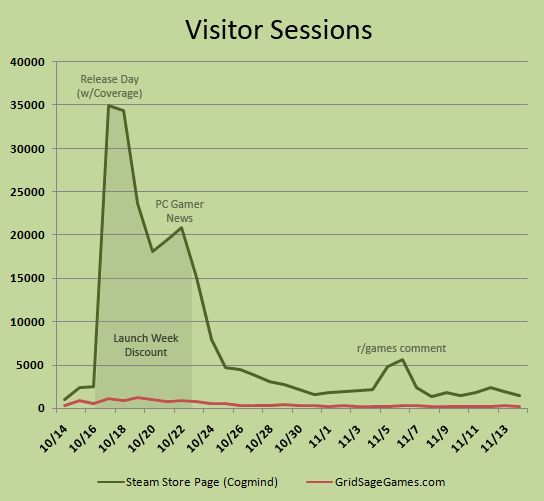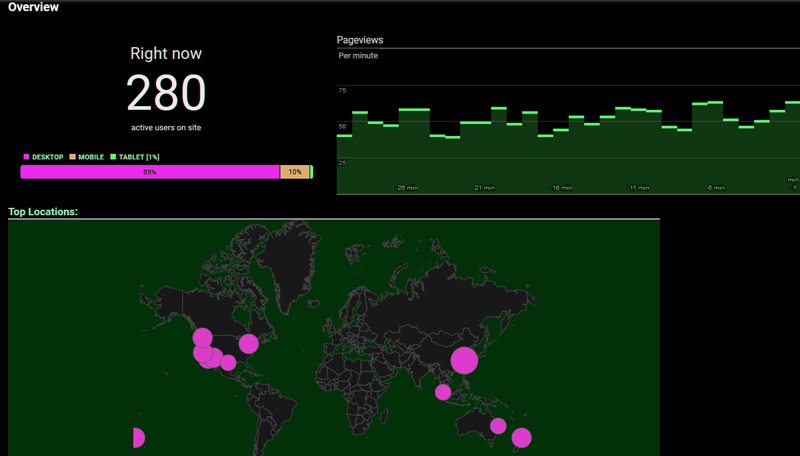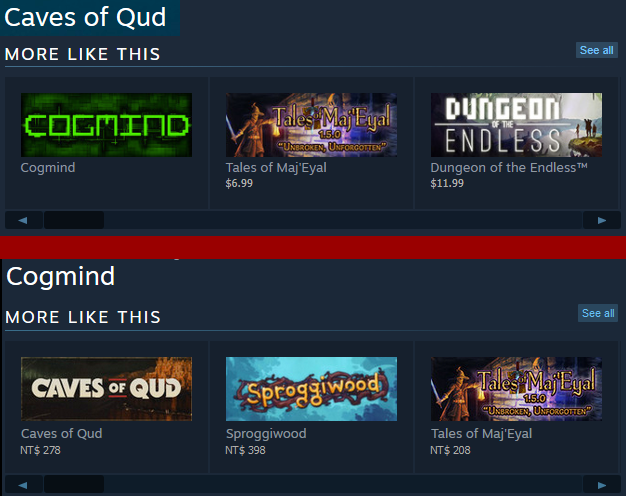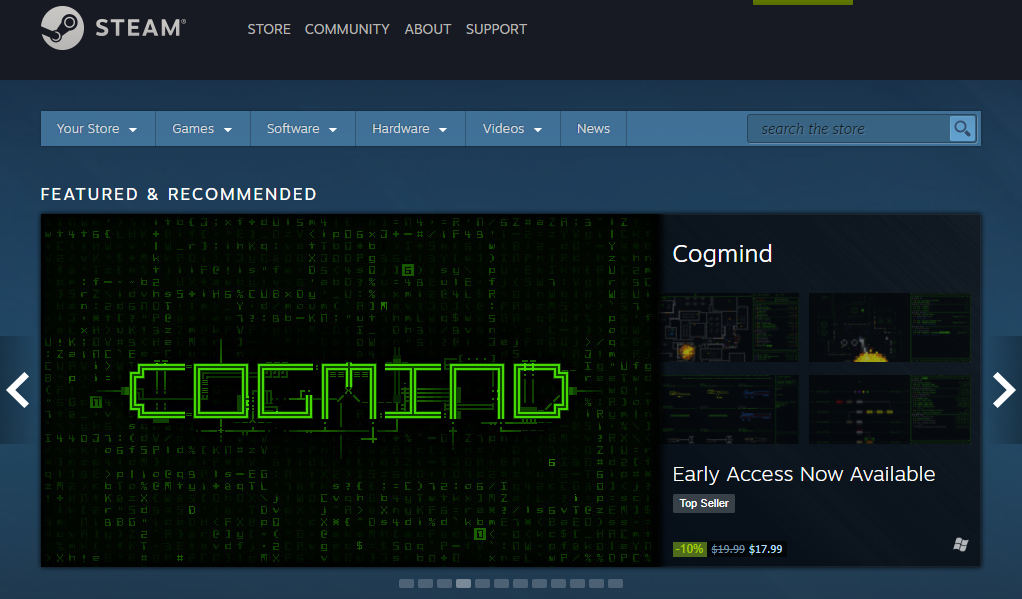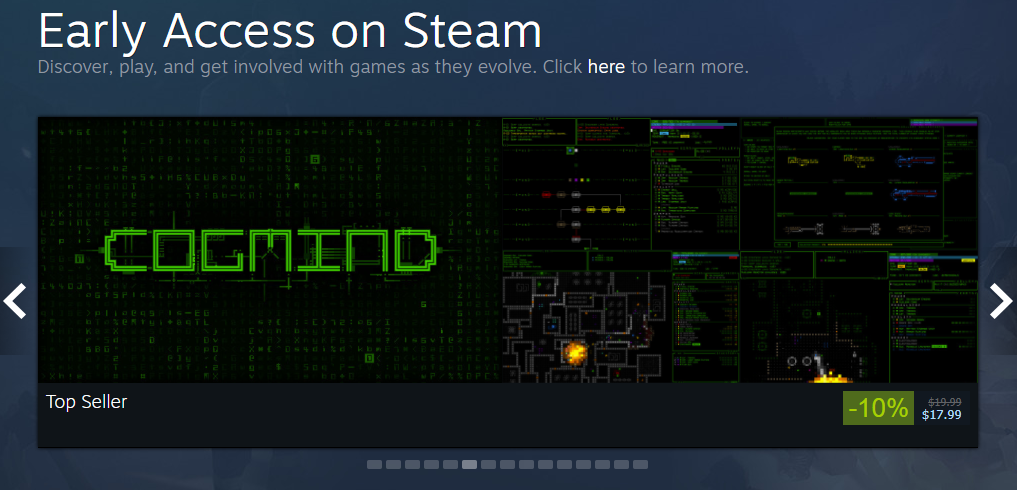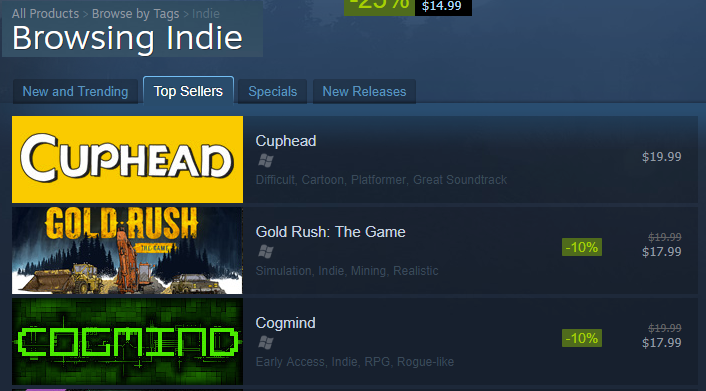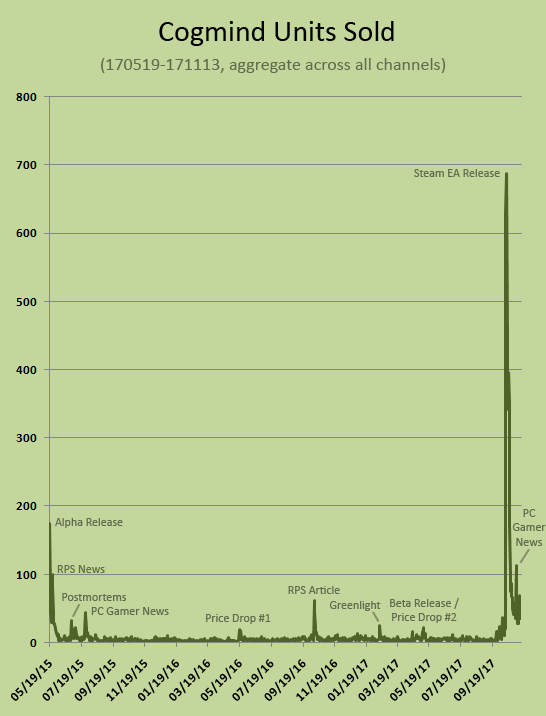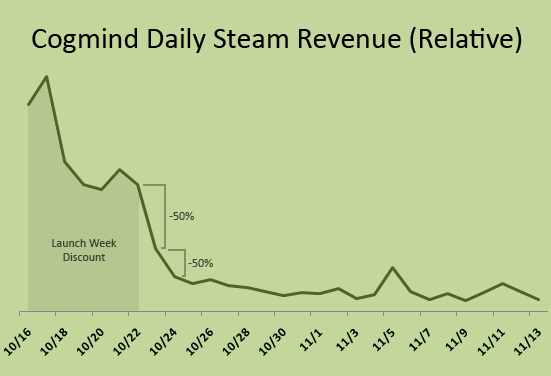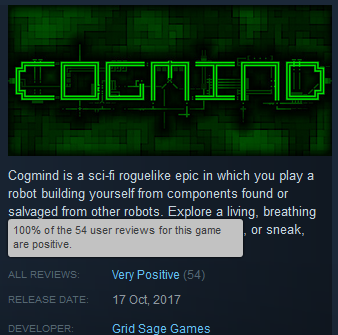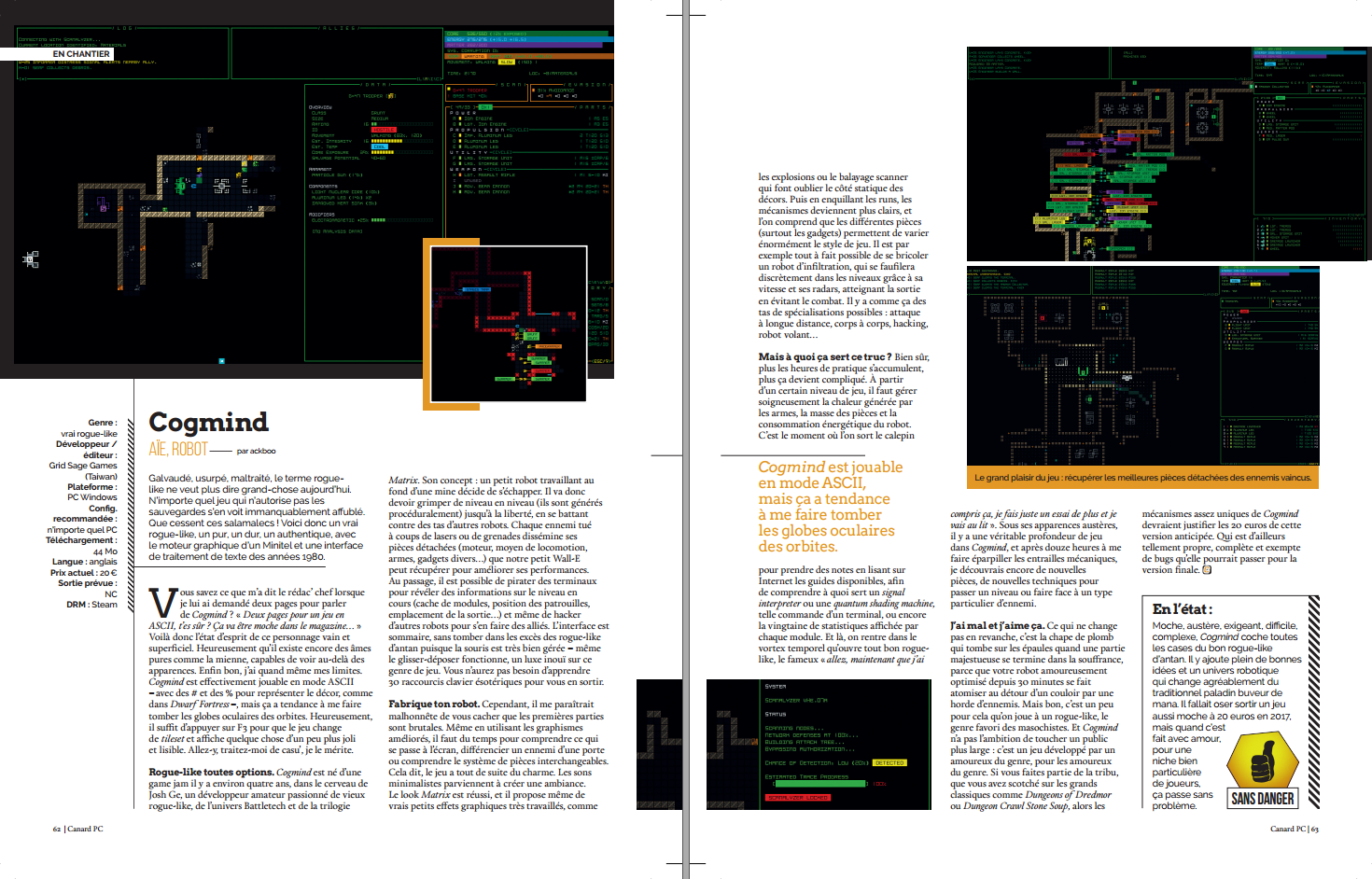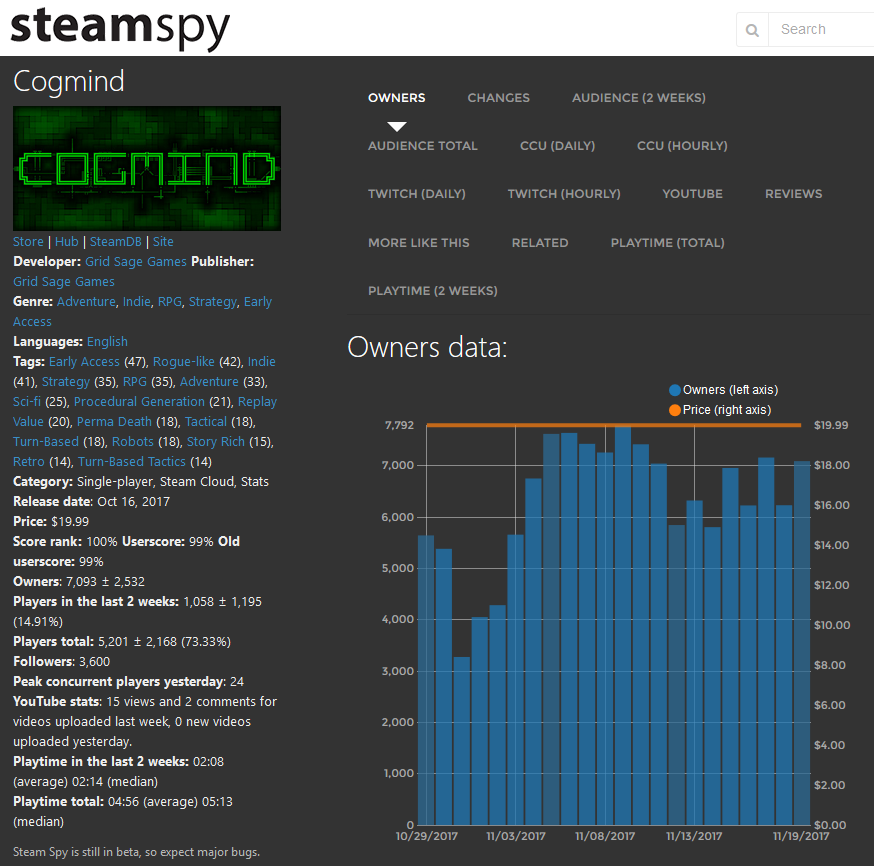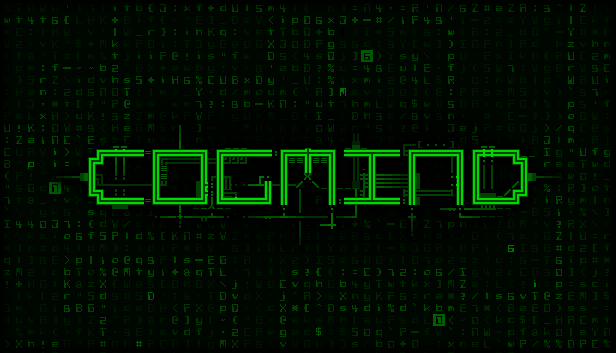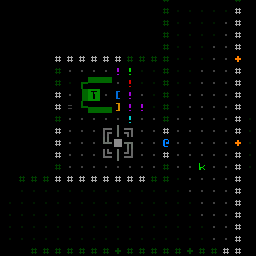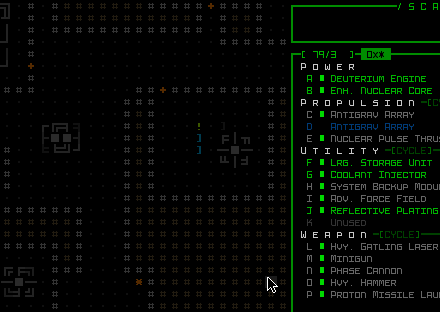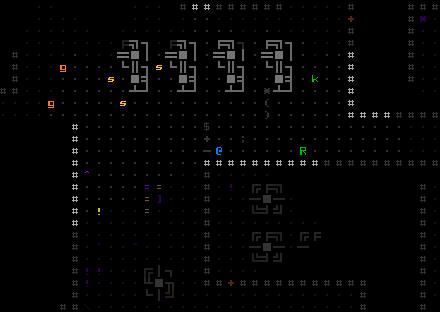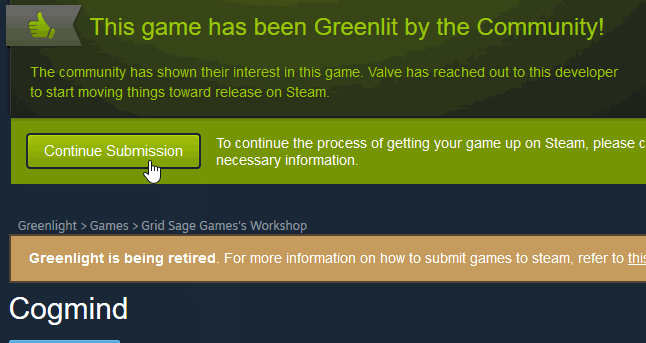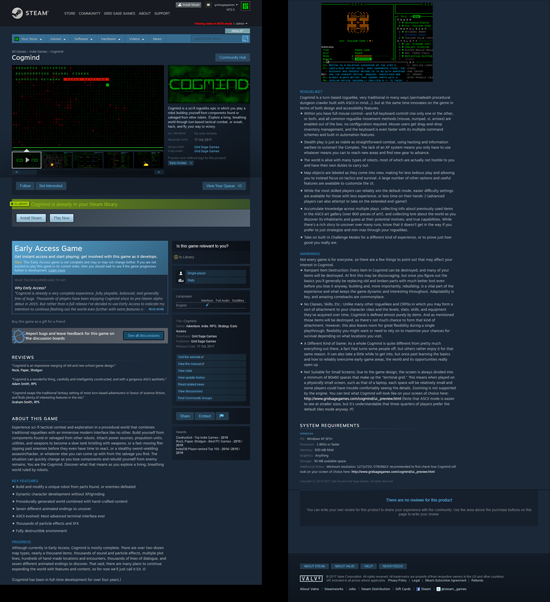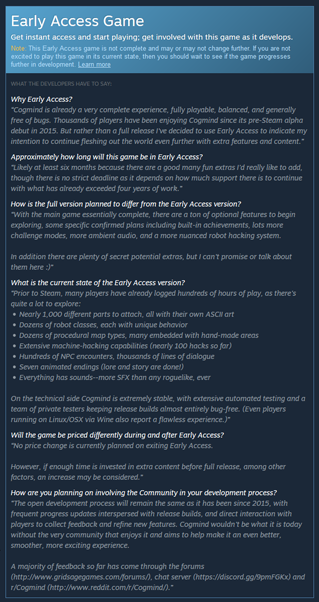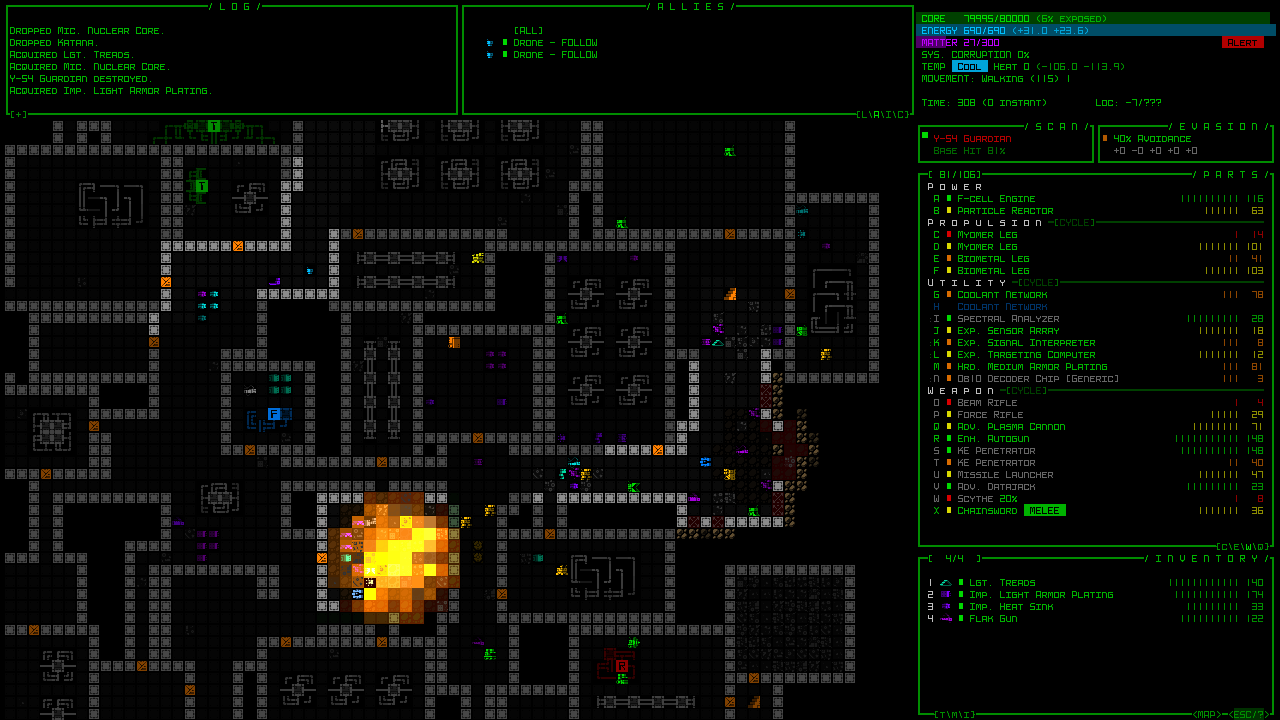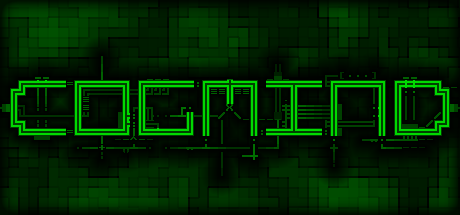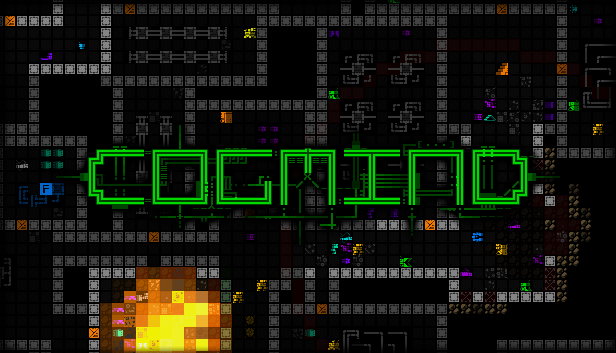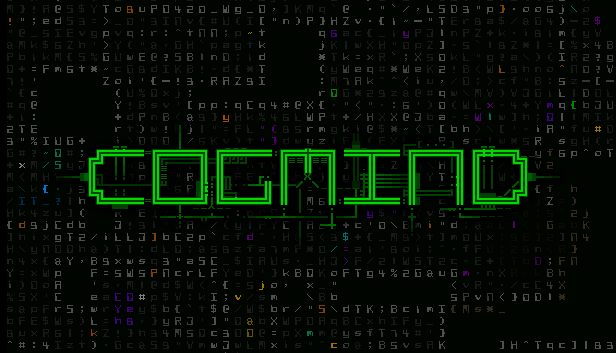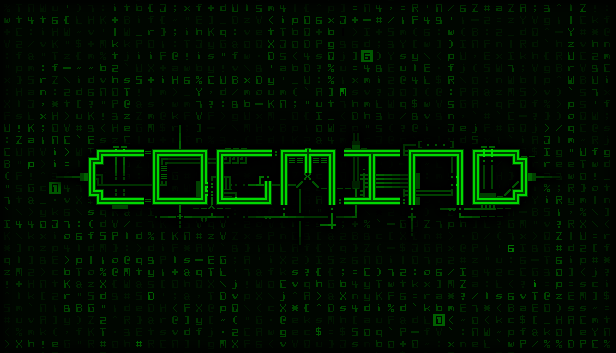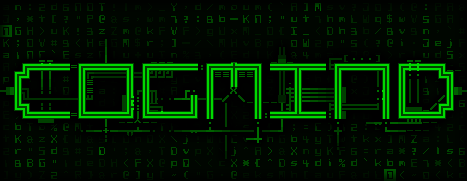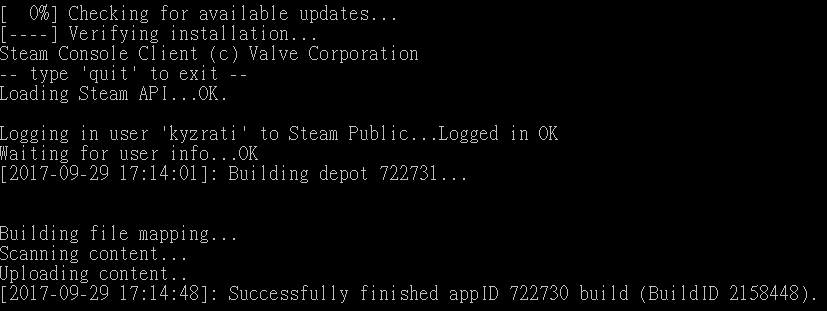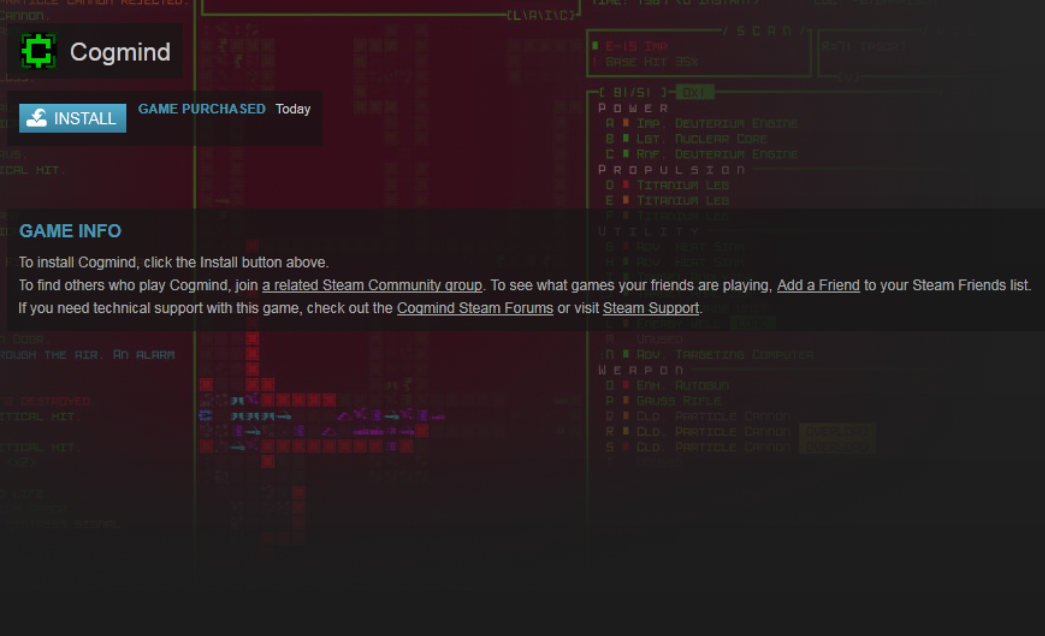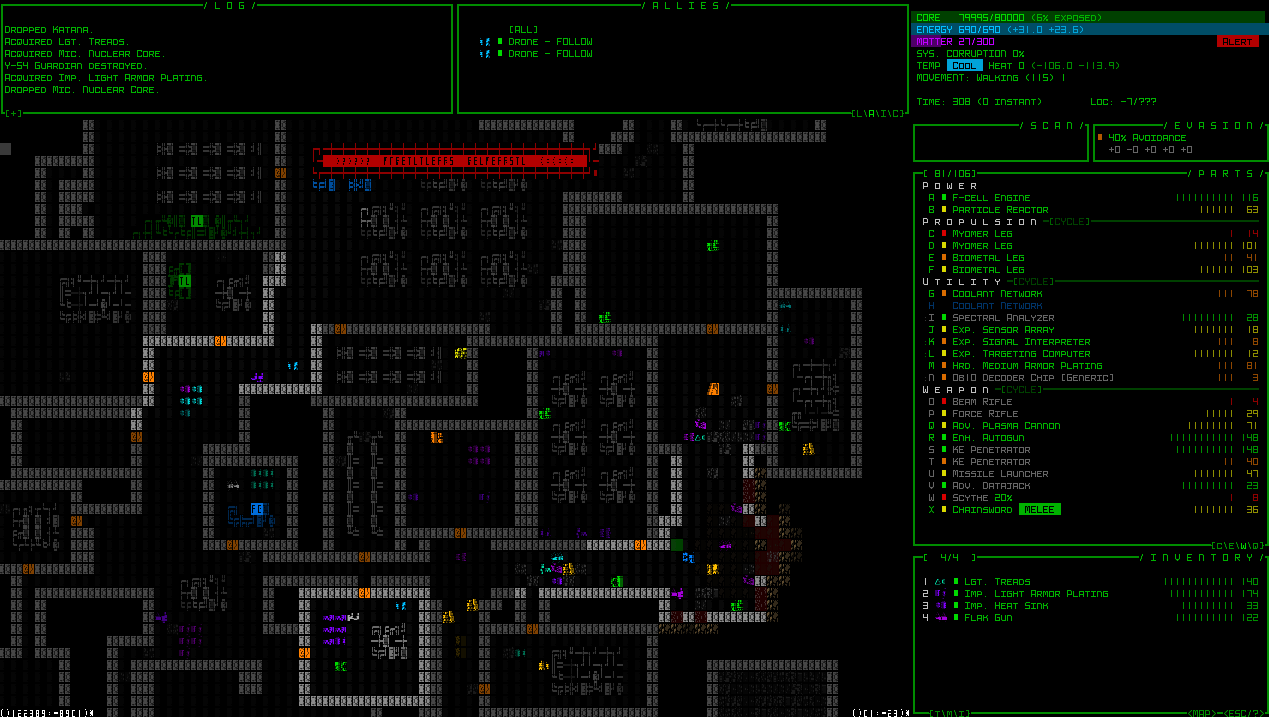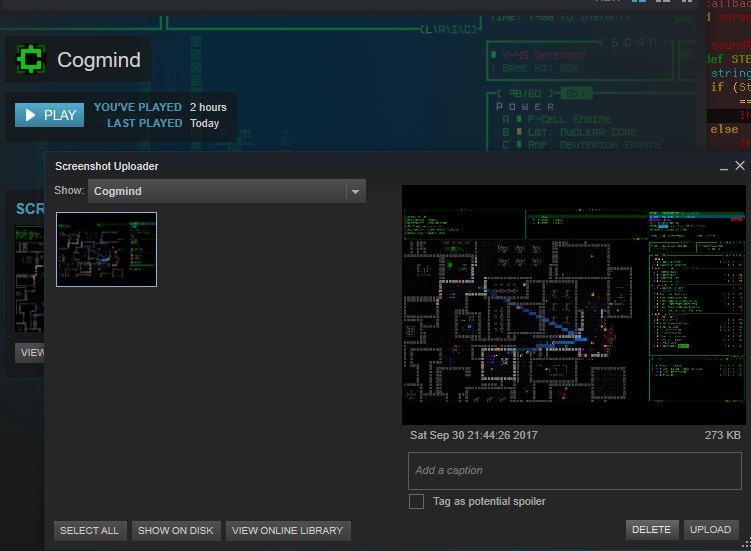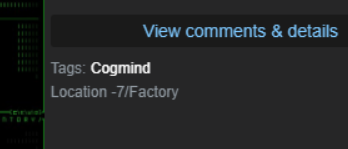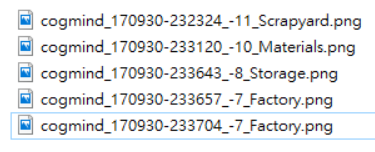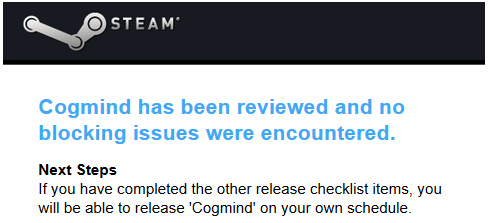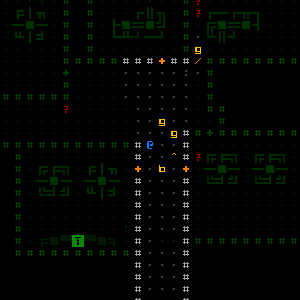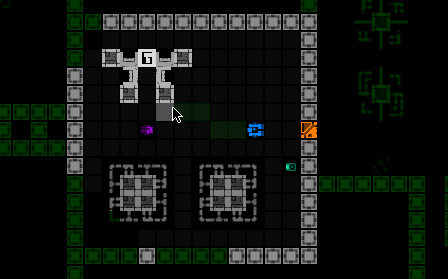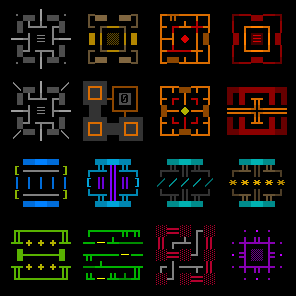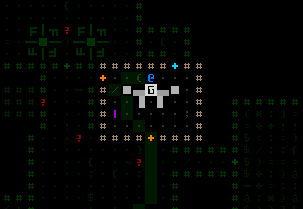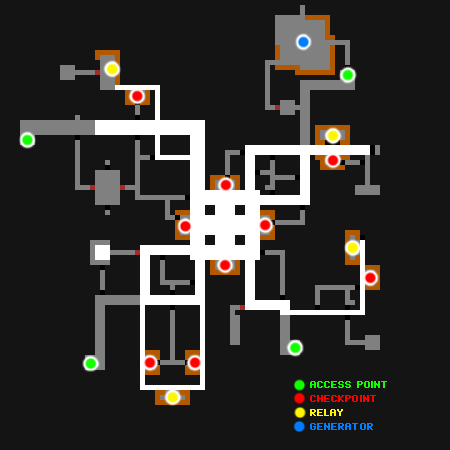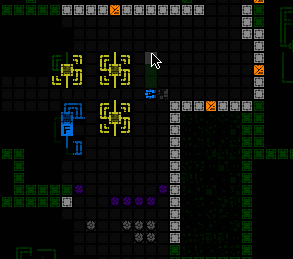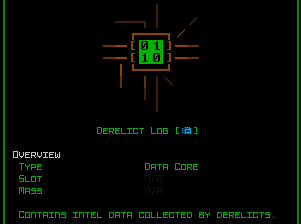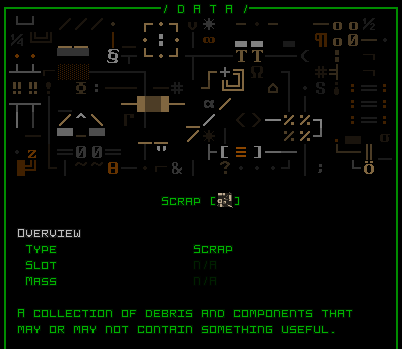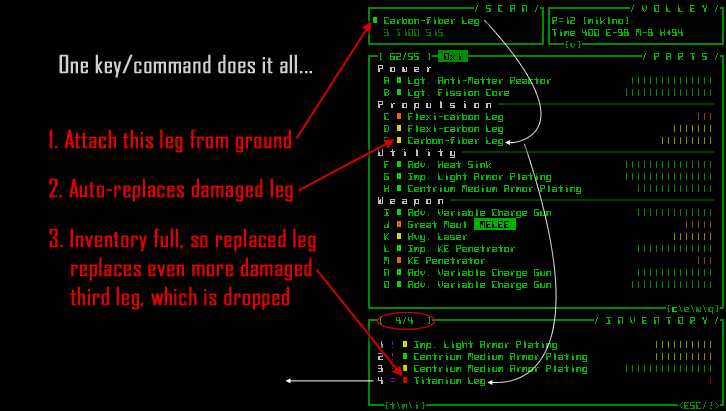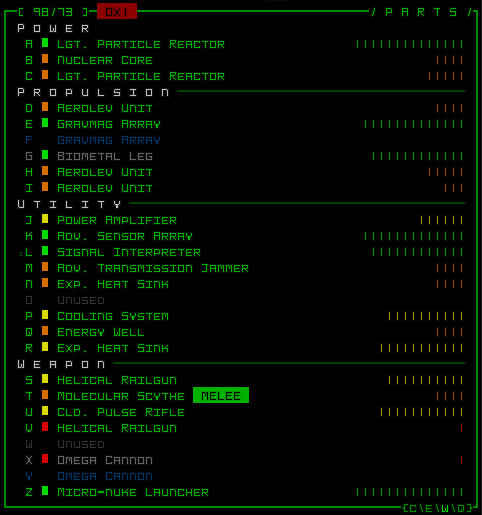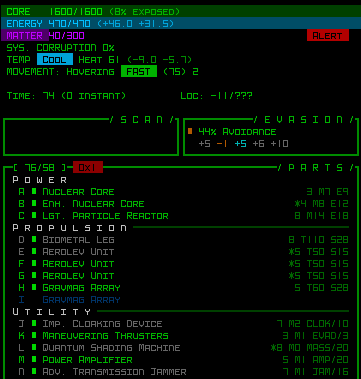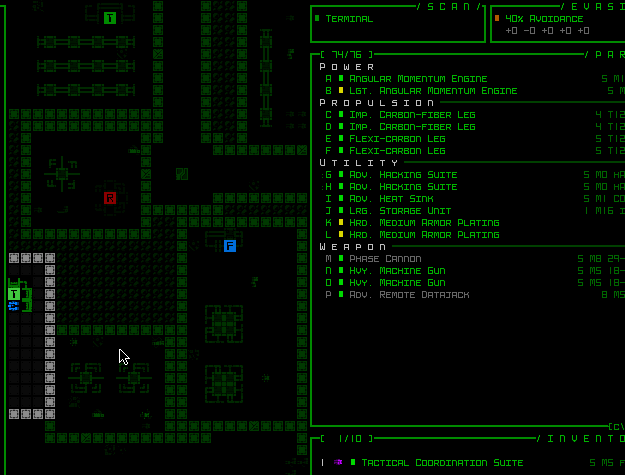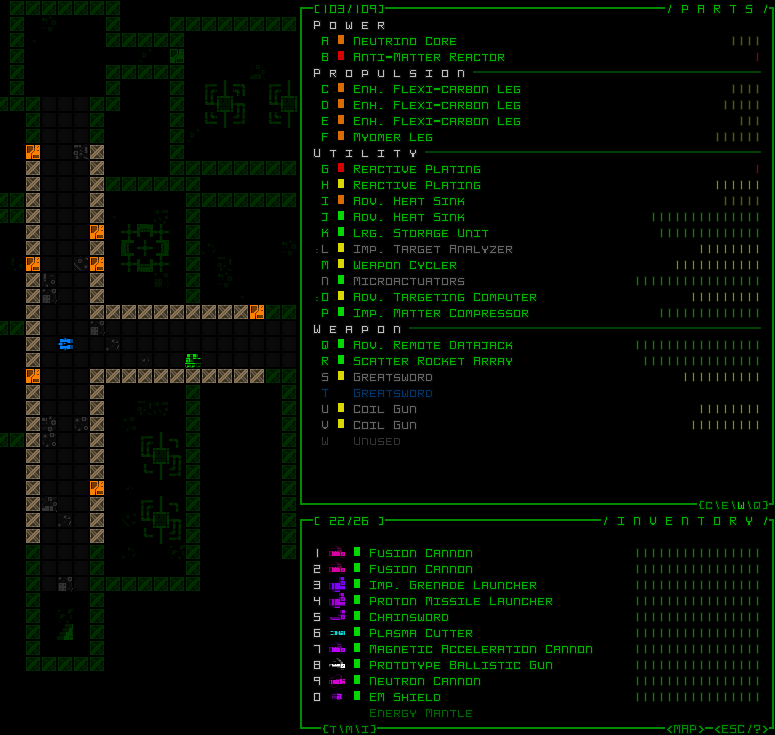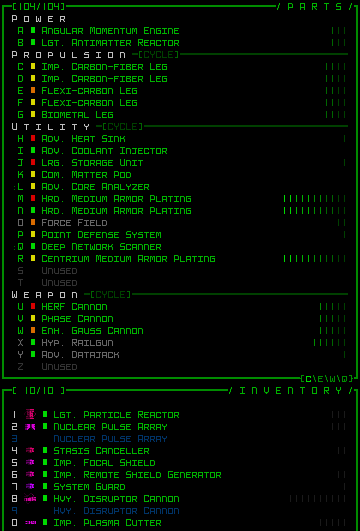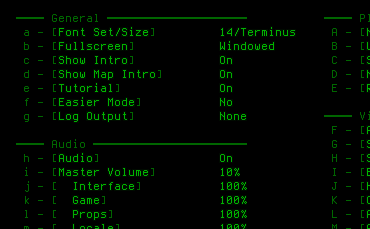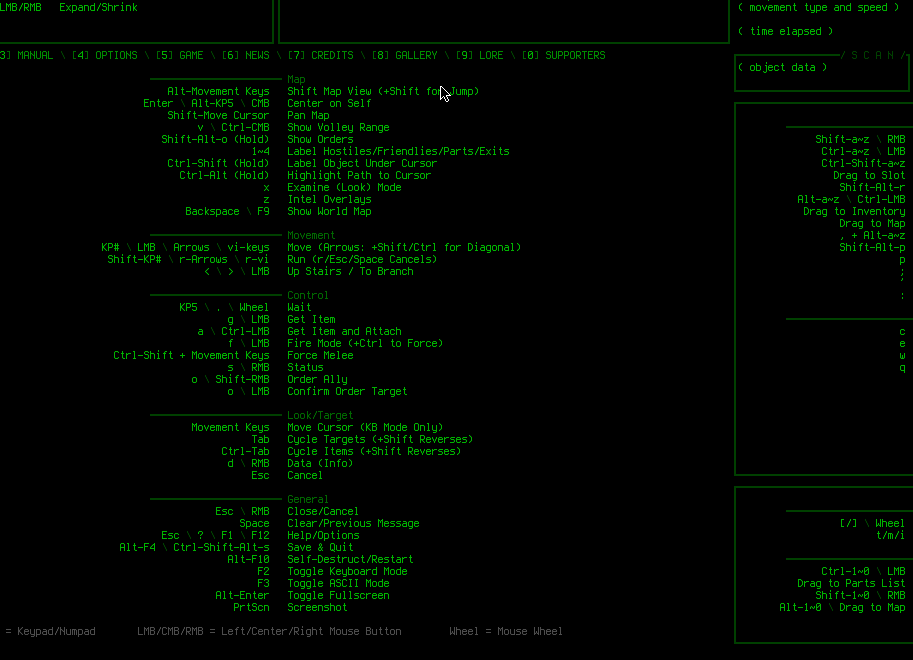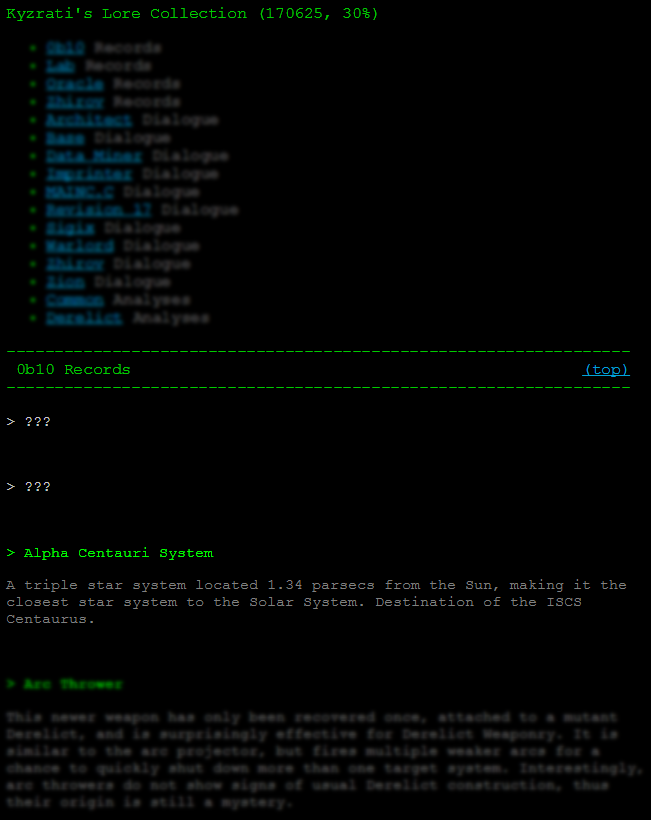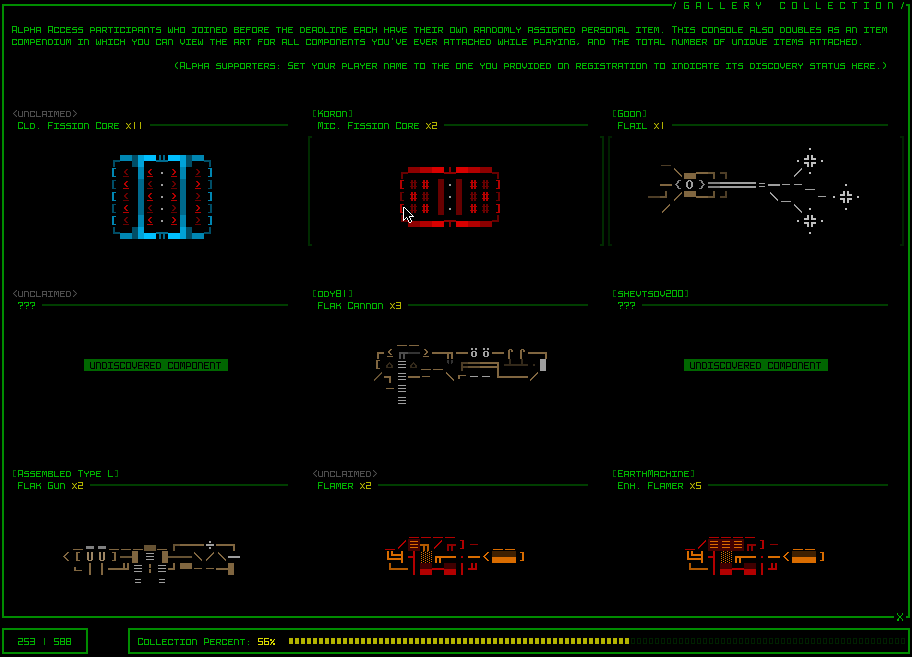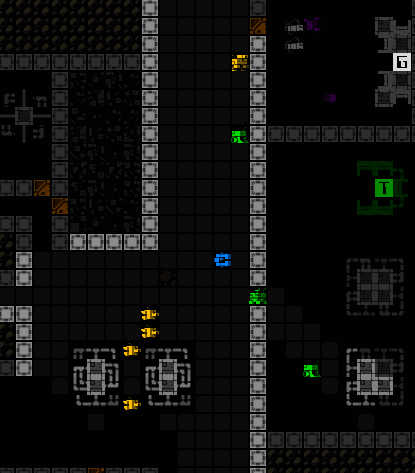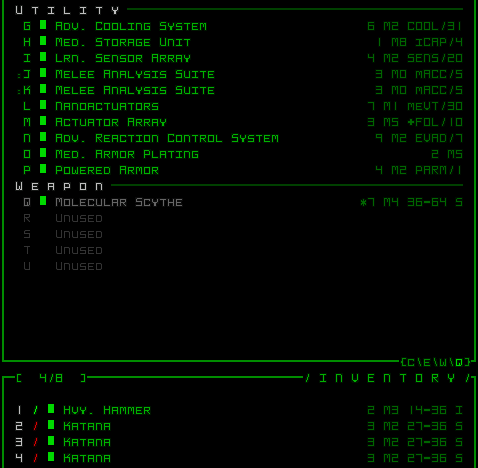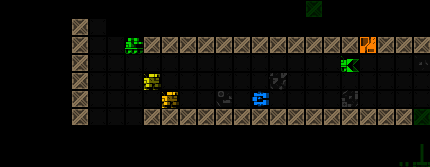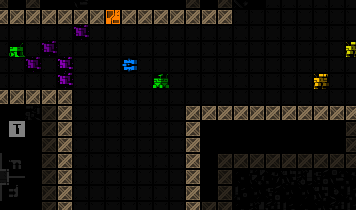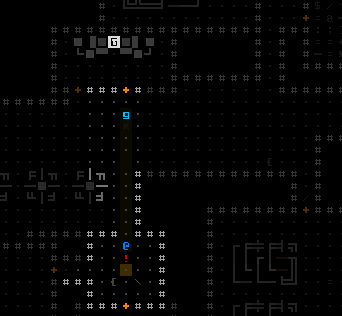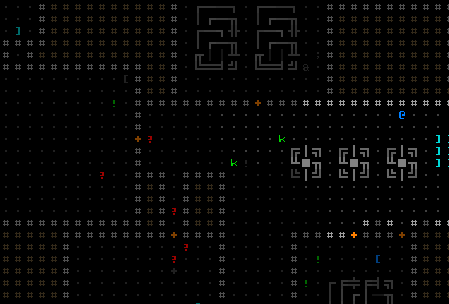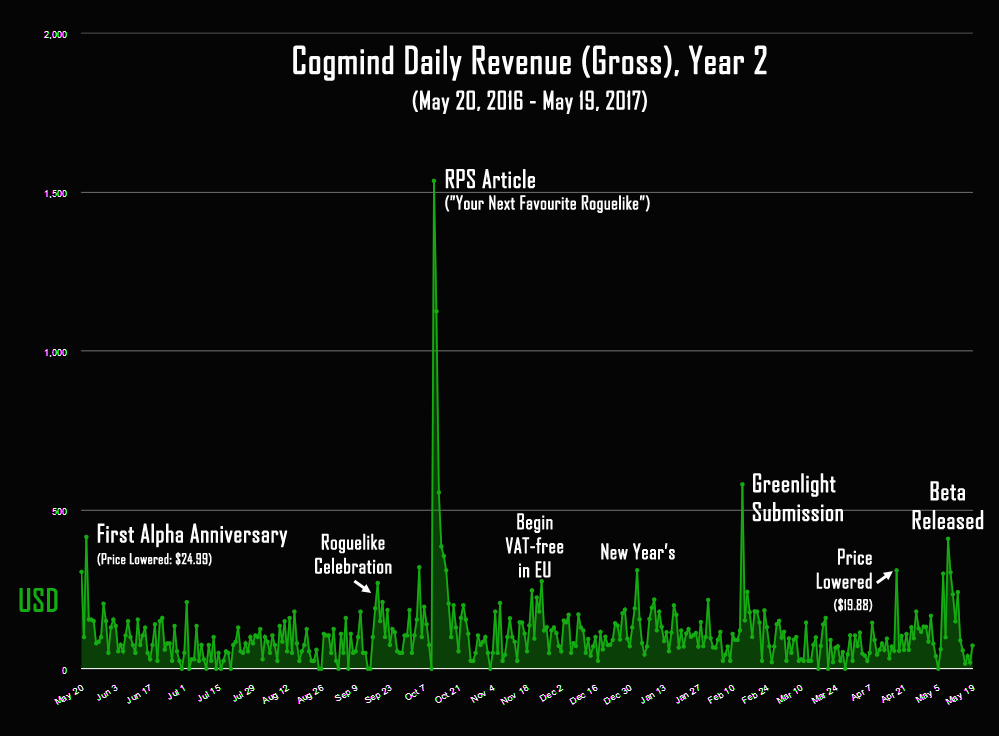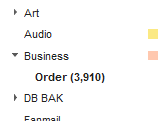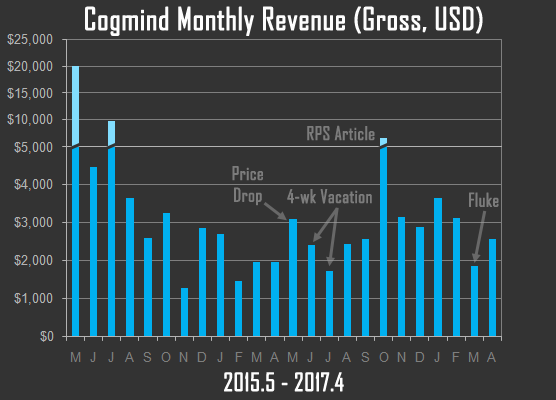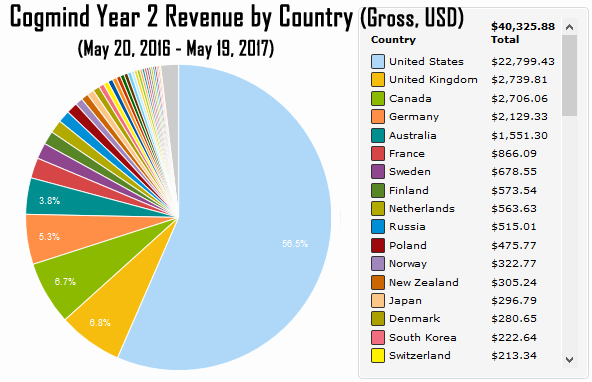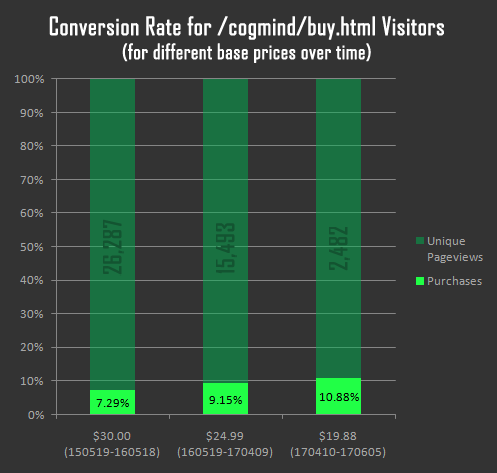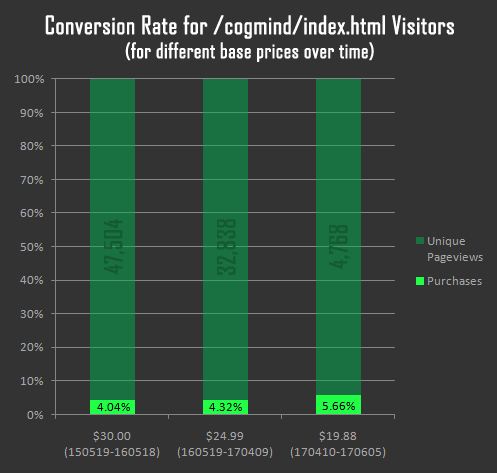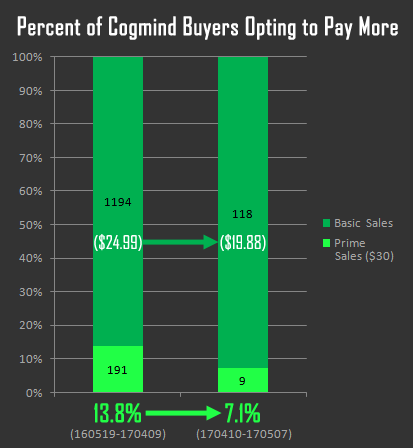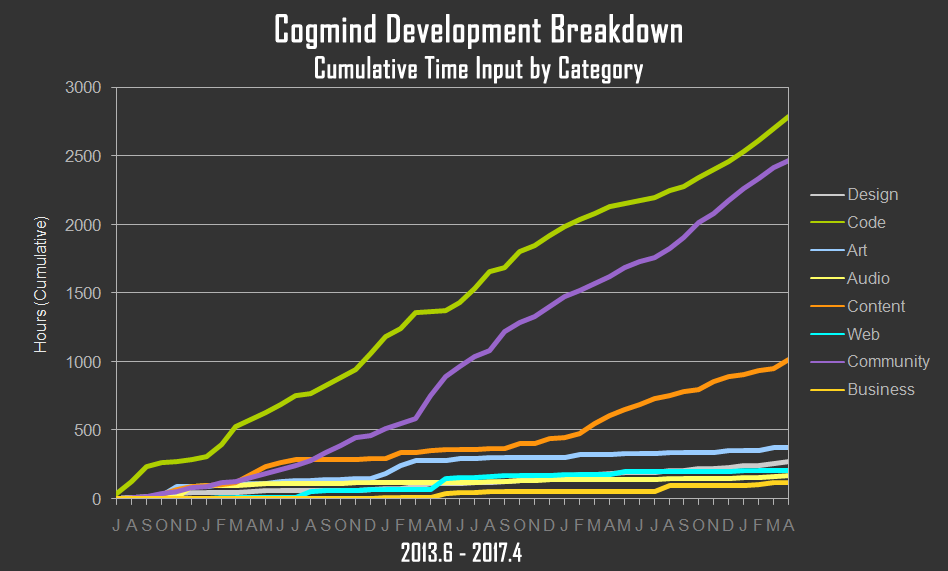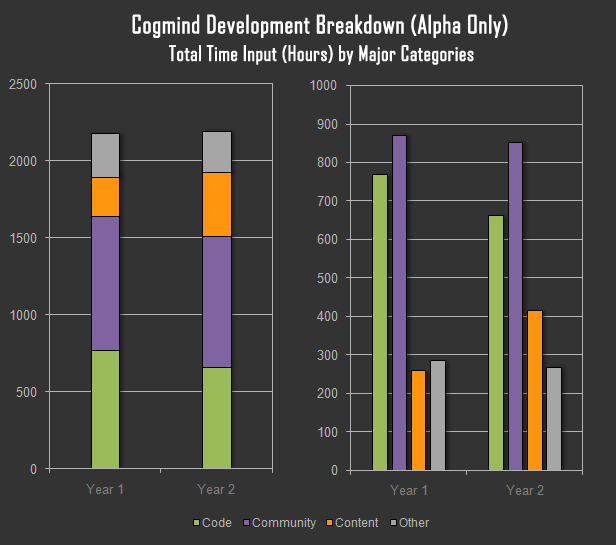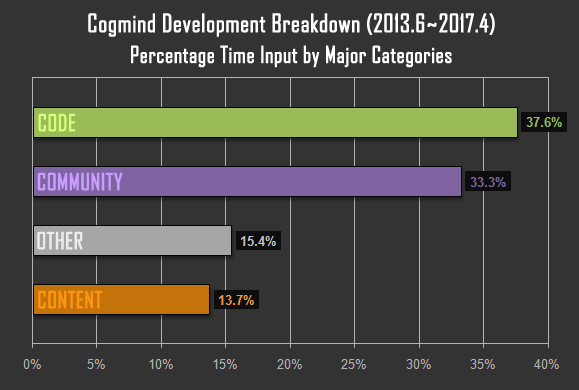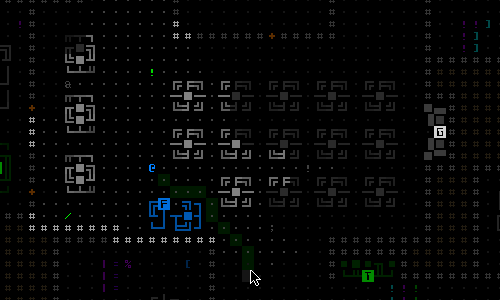So last month Cogmind “launched” … for the second time :P
It’s now on Steam EA and doing fairly well. Not like indie smash hit amazingly well, but that’s a given considering it’s way too niche for that kind of attention. Still, the relatively unexciting screenshots and two-year-old alpha trailer are apparently sufficient to attract the type of player who will enjoy Cogmind, and that’s all that really matters.
To be honest, going into Steam I had zero expectations, which from a sanity point of view is probably the safest way to do this sort of thing. Cogmind’s “first launch” was Alpha 1 back in 2015 (see the comprehensive month-1 postmortem), and at the time I was pretty nervous/excited, but also had more savings remaining to fund work on it (regardless of sales), plus the project was flexible enough that if necessary it could be completed in a short while. (In gamedev time, a “short while” means a year or less ;D) Since then I’ve already found there are just enough players out there to keep development humming along, even without help from Steam, so while putting Cogmind on another platform was a big move that could affect the feasibility of long-term development work, whatever the result it wasn’t nearly a make-or-break thing for the current project like it is for a lot of other new devs.
I must say it feels really good to have this milestone behind me. It’s nice to no longer have that pressure building in the background--I was starting to worry about Steam’s rapidly changing landscape:
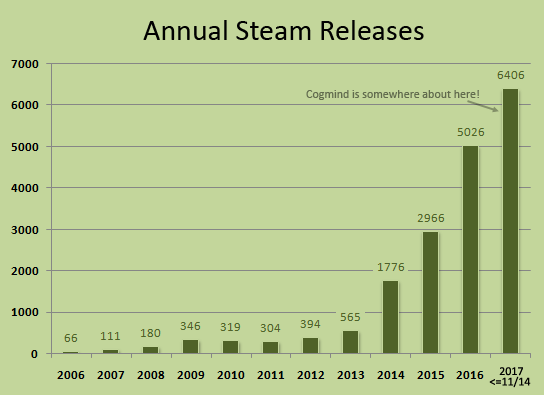
Number of games released on Steam each year, as of November 14th, 2017 (source: SteamSpy).
Nearly as many games were released this year so far as the entire 2006-2015 period. Now that anyone with $100 (and a game with some semblance of playability) can release on Steam, the flood gates are open and tons of people are doing just that. A good game with decent outreach can still do fine, but Steam is notoriously bad at “discovery” in the first place, and the sheer number of games means the exposure value of being on Steam is greatly reduced, and getting worse each day.
This trend was inevitable, but I didn’t quite have enough time to get in ahead of it.
Still, in hindsight I continue to stand by all my previous decisions, such as with regard to pricing, releasing only via my own site for the duration of alpha, and extending development to include more features and content.
Earlier I shared what goes into preparing for a Steam release, and now it’s finally time to talk about Cogmind’s first month on a new platform! We’ll be looking at reception, rankings, traffic, sales, and more.
Traffic
First of all, let’s look at the traffic data to help give the rest of this article some context. (*Note that some of the data in this post is not equivalent to a month beginning on launch day, because it was compiled a bit before the month ended.)
It’s easy to see that although over this period my own website saw a respectable number of sessions (16,103 in all), this value was dwarfed by total visits to the Steam store page: 236,665!
So while long-term exposure on Steam isn’t what it used to be, quite a lot of fresh eyes will be seeing a new game for the first time on launch day. Not to mention technically the above are people who actually visited the store page, whereas so-called “impressions” (those who had a chance to see the name and logo w/link) were much much higher. Although I have that data, I can’t release the specifics because it’s under NDA (unlike the above graph, created from my own Google Analytics tracking data).
There were not a lot of noticeable events worth annotating on the graph, at least not compared to my previous postmortems, but that’s partially because much of it is overlapping within this short period and therefore doesn’t stand out. A bigger reason would be that a mere 10% of Steam sessions originate from external websites, e.g. Reddit (about half of such visitors), Google, Twitter, and others.
So 90% of traffic is actually coming from within Steam, which itself has a huge range of different sources. Steam breaks them all down into narrow categories, but I’m not allowed to share all those details here. However, I will say that the largest chunk of Steam traffic comes from tag pages, and specifically within those lists the New and Trending tab which I’ll talk about more later.
The only two post-releases blips so far on the sessions (and therefore sales :P) graphs are:
- PC Gamer: Just a little news piece announcing Cogmind’s arrival on Steam. PC Gamer was the only major news outlet to run anything during the launch week.
- A comment (not even a post, but a comment!) on r/games. A lot of good games were discussed in the thread, and which was itself highly upvoted. Word of mouth is so incredibly valuable for indies :)
Notice the significant drop-off following the first week. There’s no way to know for sure, but based on anecdotes and past experience I’m guessing it would’ve dropped off even sooner had I not chosen to go with the 10% launch discount. Valve recommends launching with a discount, and it’s yet another factor that Steam might use to promote a game more heavily throughout their site. Not to mention it attracts more visitors who see a game available below full price (Steam also intentionally makes this information very prominent… everywhere).
About 73.8% of visits happened while the sale was active, and we’ll see that reflected again in some of the following sections, though I’m very interested to see whether/how that ratio changes in the future when not mixed in with so many launch factors.
Another fun little statistic to look at is the store page’s real-time visitor count. This is about where it peaked on launch day:
I launched shortly before 6 PM US Pacific Time, so it was late in much of the US and Europe was already asleep. The number of concurrent visitors would probably have been higher if earlier in the day, but I chose the most suitable time for my own time zone (9 AM!) because I’m working on this alone and have to field all questions and issues myself, after all.
Charts and Algorithms
Being far too busy with other work, following the launch I wasn’t glued to charts (or revenue, for that matter), but I did have a browser set up for occasionally checking in on various Steam lists to see how Cogmind was faring for the first week or so. This was mostly just to get a better idea of the state of the market. I watched these via a US VPN so as not to taint the data with my own profile.
Steam has a massive user base, of course, and where a game is placed or highlighted on their site will have an equally massive impact on sales. Funny enough, in general a game must be able to drive sales for it to get on, or stay at, a prominent place on most of these charts in the first place, so it’s kind of a chicken and egg question. Being a good game in the first place definitely helps here, as does pre-release hype to attract a surge of early buys and interest. Equally important is having a preexisting community to start it off and help sustain the momentum, which is further supported by organic word of mouth and random coverage (which I’ll talk about later). That said, almost any game has an audience out there and will manage to get some initial sales--there are simply so many people watching.
As mentioned in my steam prep summary, regarding exposure it’s both possible and important to have a game’s store page published before release, as early as possible. In addition to simply building interest, it also allows prospective players to wishlist it in order to be notified on release. Yet another benefit is that prior to release the game can apparently even get some placement on other Steam pages. While the “Upcoming Releases” list is not so valuable to anyone now (players and devs alike) due to the flood of games, Cogmind in particular was immediately paired with another popular roguelike, Caves of Qud:
Each of our games occupied the top slot of the “More Like This” suggestions on the other’s store page. In fact, I haven’t checked lately but this was the case from the first day Cogmind’s store page went live through to more than a month after release. Steam may be bad at discovery, but this is a no-brainer :P. Although Qud and Cogmind are technically rather different games, there’s a lot of overlap between the player bases and the two are often brought up together across the web in numerous discussions, even in many of the same articles (for example here on PC Gamer). This is interesting because it seems to imply that Steam algorithms uses some outside criteria (considering Cogmind had no prior presence on Steam), unless perhaps they simply noticed on day one that a lot of people who own Qud had also suddenly wishlisted Cogmind (?).
Now on to the placement following launch…
Steam users can browse games by category, e.g. Action, Adventure, Strategy, and within each category are four tabs: New and Trending, Top Sellers, Specials, and New Releases. The latter list is simply chronological and not all that interesting, given that new games disappear pretty quickly as a couple dozen more are released every day. “Specials” is for anything on discount, which technically would include Cogmind and its launch discount but I didn’t follow that so don’t have anything to say there.
Putting Cogmind out there is actually the first time I’ve ever really used Steam, and launch day was my first time looking at these charts so this was all new to me. At first I didn’t even know what kind of charts I should be watching, but come launch day others on Twitter were pointing out Cogmind performance on various charts so I figured those were good to keep an eye on :P
I mostly followed the Early Access category (duh), Indie, and Strategy, about which I’ll provide details in the following sections.
Main Carousels
A “carousel” would be the collection of large images prominently displayed at the top of a page, a select few games that users can cycle through and which Steam wants to promote for whatever reason. They actually list the reason below each game, be it because it’s currently selling well, it’s new and trending, or the user has showed an interest in such games before, etc. Games included in these carousels are swapped in and out fairly frequently.
Of course the most prominent carousel of all would be that on the front page of Steam. With The Flood upon us, front page exposure for new games is no longer guaranteed, but games that are popular or selling well can end up there organically. When Cogmind launched, surprisingly the initial surge of purchases was enough to get it on the front page, though only for a brief time. It was there for perhaps an hour or less, and didn’t bring in much traffic at all compared to other sources.
Still, it was definitely cool to have my first commercial game featured on the front page of the largest video game platform in the world. So of course I had to screenshot it :)
There’s no way a niche game like Cogmind could maintain a presence on that page for long (even less probable as an EA title), not to mention about a third of the slots were taken up by various Witcher products… Apparently I released on the same day as a 10-year Witcher series-wide sale, but the market is so active these days that if it’s not one thing it’s another, so no sense in putting too much effort into finding the best release window! (Technically I can identify some undoubtedly better windows, but they push the release back into next year and I didn’t want to wait that long considering Cogmind was ready. Interestingly, not long before launch I read an article about another indie studio that postponed releasing their already-completed game to next year.)
Much greater numbers of visitors were brought in via carousels on relevant category pages, where Cogmind enjoyed prominence for multiple longer periods.
Cogmind sat on the Early Access carousel for almost the entire first three days, displaying the reason as “Top Seller.” Then it disappeared for a few days before returning once again for the same reason, not coincidentally on the final day of the launch week discount. I wonder how Steam figures that, though, because sales were mostly declining in the lead up to that day. My guess is they’re probably also factoring aggregate sales over the previous week (or something like that) and also giving an extra boost to new games nearing the end of their sale period since a looming deadline can spur people to buy if they’re on the fence. On that note I did see some meaningful anecdotal evidence, several people saying they wanted to catch it before the discount ended.
In the Strategy category, for the first two days Cogmind also sat in the main carousel, often as the leading game (!). This definitely surprised me since this category includes all Strategy games on Steam, not just Early Access. I had thought releasing Cogmind as EA would relegate it to a smaller subset of the site, mainly the EA-specific area, but that’s apparently not the case. Strategy is one of the somewhat smaller categories on Steam, and I guess there weren’t as many big strategy titles released around this time, so there was space for a niche game to edge its way in there :)
I don’t think Cogmind ever appeared in the carousel of the other category I was keeping an eye on: Indie. That wouldn’t be a surprise since it’s without a doubt the broadest and most competitive category these days.
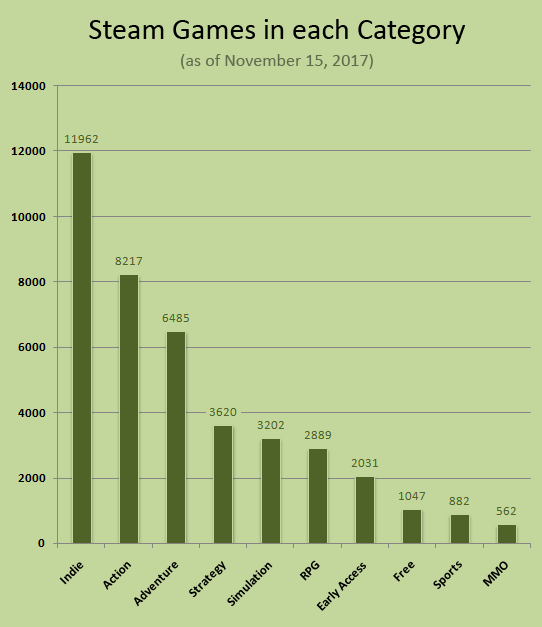
Steam games in each category as of November 15, 2017 (remember that games can belong to more than one category!) (source: SteamSpy).
New and Trending
Based on store page visitor data this tab is source of the most visits compared to other tabs (by far)--the average user apparently doesn’t browse tabs such as “Top Sellers” all that often. This makes sense because that list is repeatedly dominated by the same few popular games anyway (even if others manage to occasionally edge their way in). New and Trending, on the other hand, is filled with mostly new (or recently updated!) games, so this is a more interesting list for users to browse, and therefore more valuable for developers to have their game appear on. Games that update often get more exposure here. This category also includes games that are simply “trending,” so even without an update those with lots of new page hits have a chance to rank here, too.
On the Early Access page, Cogmind was the #1 New and Trending game throughout the first day, though naturally started dropping over the second day as other major EA games were released. By the fourth day it was down in the middle of the second page. (Note that each page lists 10 games.) On the sixth day PC Gamer posted the release news and Cogmind was once again up on the first page, at the bottom, so store page activity is definitely a factor.
Under Strategy, Cogmind was also the #1 New and Trending game for most of the first two days, though by 48 hours it was pushed down to #2 as a non-EA strategy game took the lead. Overall Cogmind sat on first page for most of the week.
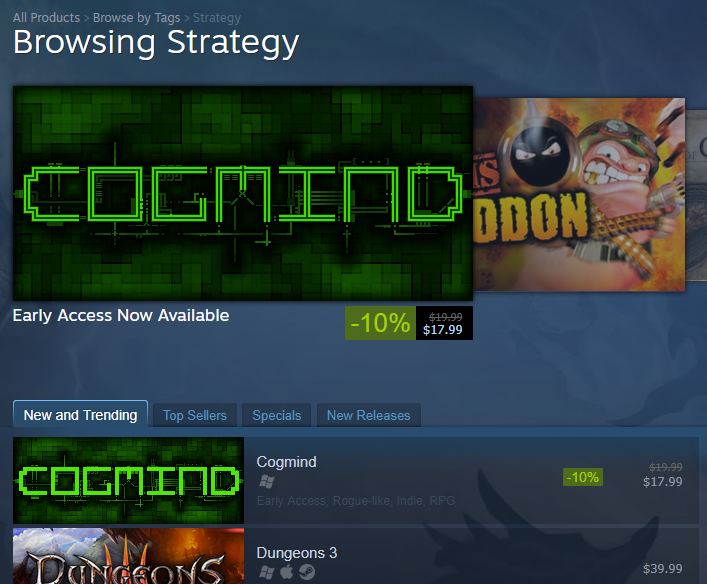
Cogmind topping New and Trending in Strategy, and leading main Strategy carousel, during launch week.
Launch week performance on the Indie New and Trending page was very similar to that of Strategy.
Top Sellers
This would be the category devs are especially interested in watching :P. If we can’t make enough revenue, then we can’t develop more games--or in some cases even *gasp* finish the ones we’re working on!
An interesting note about the Top Sellers charts: Rankings really are by how much money games are pulling in over the previous hours, so you know that games above you are making more per hour, and those below are making less per hour. Therefore, once you’ve had a game occupy various positions on this chart, the values are consistent enough that you can essentially know how much money other games are bringing in (even once you’ve fallen off the charts). Cogmind did really well on Top Sellers lists for a while, but as a really niche EA game naturally didn’t hold top slots for long. By comparison a number of popular games are high on these lists all the time, and wow some of those games are really raking it in… You can more or less already have a general idea of sales performance via SteamSpy, though knowing the “value” of a Top Seller slot enables you to much more accurately calculate actual gross daily revenue.
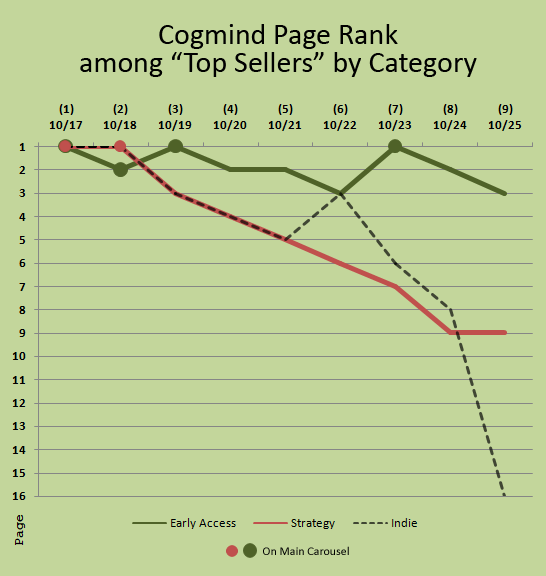
Cogmind’s Top Seller page rank (10 games per page) in select categories over the first nine days. I’ve also marked the days on which Cogmind spent a lot of time in a given category’s main carousel.
With a surge of buys from fans waiting for the moment of launch, Cogmind was #2 EA Top Seller right away, under PUBG. That would be a tough one to unseat, though I did hear that Cogmind held the #1 position for short time around noon during its first full day on sale in the US (but I wasn’t awake to see it). The third day’s resurgence back to the first page was likely due to quill18, who had begun uploading his Cogmind stream videos to YouTube. This is more apparent on the sales graph rather than raw visitor sessions, because the people coming would naturally be more interested in this sort of game and therefore more likely to buy than the average visitor.
As mentioned earlier, Cogmind reappeared in the EA main carousel on the last day of the launch sale, and likewise you can see in the graph that it was also back on the first page. On the tenth day it had completely fallen off the EA charts, though reappeared on the fourth page when I later checked during the r/games comment. That single comment definitely gave a nice sales boost! Around this time it was also pointed out to me that Cogmind was in SteamSpy’s Top 20 trending games list, and also the highest player-rated game of all 100 on the list. (It seems a lot of stats-savvy players like to follow SteamSpy, too--it’s not just devs.)
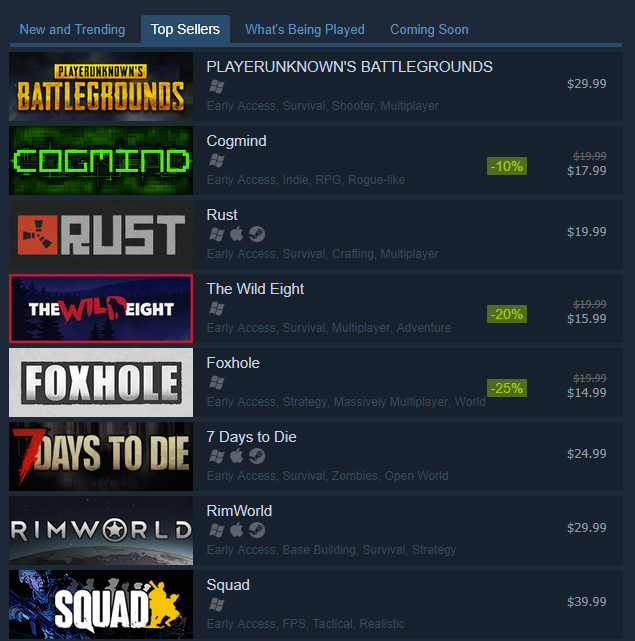
Cogmind Steam EA day 1 Top Sellers list (Early Access category). Right below PUBG is about as high as we go :P
As one might expect, Cogmind didn’t do quite as well on Top Sellers lists outside the Early Access category. The other categories also include all complete games on Steam, so I wonder how many people ignored Cogmind due to the “Early Access stigma.” Would Cogmind have fared much differently if released as 1.0? We’ll never know. (Though I still think going EA was the right way to handle this.) Regardless, Cogmind’s performance on those charts certainly wasn’t bad!
Gold Rush was a fairly popular non-EA game released on the same day as Cogmind, so it ended up nearby on a number of charts. Cuphead is of course the latest indie sensation so no surprise to see it up there. I think the highest Cogmind managed was the #3 Indie slot, and only for a few hours on the first day. Only two EA games appeared on the first page: Cogmind and Rust. Everything else was a full release. It’s a competitive category, after all, with 66.6% of games on Steam marked “Indie.”
Cogmind slipped off the first Indie Top Sellers page on the first day, but came back before long as the US woke up, again making it very clear where Cogmind’s primary player base hails from (about half of players are in the US, unchanged for the past couple years). After that it was mostly downhill, though as a large category even being dozens or more games down the list Cogmind was still in good company, like on day nine when it had fallen to page 16 (games #161-170) hanging around with Gold Rush (still :P), Heat Signature, and others. There are simply so many good games out there now!
Despite some upticks in EA and Indie performance later in the launch week, in the Strategy category Cogmind’s Top Sellers performance maintained a continual downward trend. A lot of new strategy games were coming out that week, in addition to new DLCs, and these were pushing other games down fast, showing that it really does matter what else releases around the same time. There are simply too many to know them all beforehand, however, and too many variables to predict how a given week will play out, so best not to worry about it.
Tag Pages
Another more targeted way for Steam users to find relevant games is to look at tag-specific lists, e.g. “rogue-like.” The top results for a given tag appear as a collection of logos rather than a list, but looking for addition results shows them in standard list format. For pretty much the entire launch week Cogmind was among the top results for its main genre tag, along with a lot of other well-known… um… “roguelikes,” yeah.
I don’t have any data to draw conclusions from this placement, though. I mean it looks cool, in any case :D
Post-release Updates
On November 12th I released Cogmind’s first post-Steam update (or “patch” as they’re called on Steam). Out of curiosity, later that day I checked a few lists to see if it had popped up anywhere and found it pretty high on the New and Trending chart in a number of categories.
That day Cogmind was back to page 1 under Strategy and page 2 under Indie, though strangely all the way down on page 9 for Early Access--perhaps EA is weighted differently? I also found it on page 1 for RPGs and page 2 for Adventure… Do these old “genre” categories really mean much anymore? Some are so vague :P. By the next day Cogmind had again completely disappeared from all lists. And there was definitely a bit of an uptick in sales around the update, too, but not by any means Top Sellers material.
The point is, updating often is a good way to naturally generate some extra exposure and sales through the default behavior of Steam’s systems. No wonder Caves of Qud patches almost every week. Seems like a really good strategy…
Sales
While Steam doesn’t permit developers to share specific sales or revenue numbers, they do allow 1) aggregate data including both Steam and other sources, and 2) use of any graphs to show relative changes without giving any values. So have a graph :D
Cogmind has already been out for a while, so a significant chunk of the core fan base already owned it by the time it released on Steam. This somewhat stymied the potential for an even bigger launch (as previously reported, over 4,000 people bought Cogmind before it came to Steam!), but as I’ve talked about before spreading the exposure over a longer period was a calculated move.
Perhaps unexpectedly to some, despite the numbers in the above graph the Steam release is not quite the boon it appears to be--pre- vs. post-Steam revenue isn’t nearly as lopsided as sales imply. Remember that Cogmind was priced much higher for most of its pre-Steam lifetime (more pricing data here). Taking that into consideration along with the extra costs of selling via Steam, honestly in the end the Steam sales are just okay. In fact, net revenue calculations show that percentage-wise a significant chunk of the first month of Steam sales were matched by my first month of direct sales! I can see why people launching right to Steam fight an uphill battle and these results further validate my earlier decision to start selling on my own back in 2015. I’ll admit it’s nice to see that after only its first month on Steam, Cogmind is closing on the gross revenue of two years of direct sales, but that’s gross revenue--a much much smaller amount actually reaches me!
Still, being on Steam now is great because:
- A lot of the people buying through Steam are people who wouldn’t, or couldn’t, buy from my site for whatever reason, either it was too pricey back then, because it’s not set up for regional pricing like Steam is, or (most commonly) because buying through Steam is really easy and convenient for users who already have an account there. When it comes down to it this means more people playing, and more revenue in the long run.
- I’ve noticed that selling both direct and via Steam has not significantly affected the volume of direct sales! This is kinda surprising, but even with Steam as an option out there, about the same number of people are buying from my site as the pre-Steam days. It might change down the line, though, since we’re still only a month past the EA release… something to look at again in the future. (Another factor to consider here: Linux/Mac players, of which there are a fair number, will prefer to buy from my site since there is no official support on Steam and Valve doesn’t make it easy for non-Windows players to acquire a Windows version of the game.)
- It’s a little easier to hand out Steam keys when I need to (and easier for people who have Steam to redeem them), compared to keys for my DRM-free system.
I also have the option for people to buy from my site (in order to better support development) and then request a Steam key, and some players have been taking that option. There are usually about one or two of these per day. I’m familiar with the number because I’m handling it manually rather than via automation :P
Anyway, the good news is there’s enough support for continued development for now. (Note: I will eventually have to write about how hard it is to stop working on a fun and popular project that has a lot of momentum…)
Wishlists
Wishlists are an interesting thing on Steam, a convenient place for users to record games they’re waiting on for whatever reason, or… ignore them forever (easy to do nowadays when there are clearly more good games available than many people have time to actually play!). There are so many different people in different situations out there that it’s hard to say what portion of “wishes” belong to a given category, which can range from simple release timing to current price, demand/interest, reviews, platform support, state of completion, hoping for someone else to gift them… too many factors!
But based on the discussions I’ve read, devs like to keep an eye on these “potential sales” waiting to happen and find ways to convert them into actual sales. I’m not going to obsess over it, though in Cogmind’s case I can factor out a lot of significant blocking factors and say that I bet a majority of my wishes are simply waiting for a lower price. (This speculation is reinforced by the apparent effect of discounts on sale numbers, which I’ll cover next.)
Interestingly, so far Cogmind’s wishlist totals track sales pretty closely. Since release the number of outstanding wishes at any given point is about 3.5 times the number of actual sales. Info from other devs seems to confirm a relatively constant ratio between wishlists and sales, though the specific ratio for each game will of course be unique to its own set of factors.
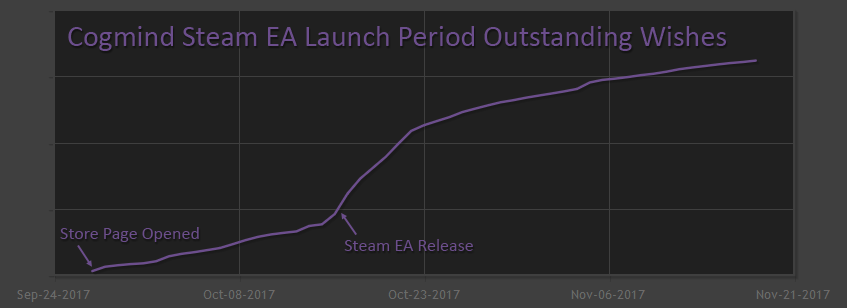
Cogmind Steam EA Launch Period Outstanding Wishes, which basically tracks the rate of sales from launch (Steamworks graph).
Many of these wishlists are no doubt waiting for the “right price,” though I don’t plan to do any heavy discounting any time soon (like, at all during EA), just the occasional 10%.
Discounts
Approximately 68.4% of total revenue from the first 27 days was earned during the launch week’s 10% discount period (which technically lasted only 6.5 days because Steam always ends discounts at 10 AM in their time zone rather than an actual week-long period ending seven days after the discount starts!). By the numbers, there was a steep drop in revenue once the discount ended, cutting daily revenue in half the very next day, and in half again the day after that, before starting to stabilize into a long tail.
That’s a steep drop. Even with the launch as a conflating factor, it’s already clear that on Steam most people want their discounts! Steam of course does a lot more promotion for games with an ongoing sale, further contributing to the already strong effect temporarily lower prices have on the natural consumer desire to get a deal. There’ll be another 10% discount coming up for the Autumn sale, and it’ll be very interesting to look at the graph again after that.
Reception
The good thing is, the launch went really smoothly. It’s great to have a game that’s already been debugged, polished and extensively playtested before bringing it to a new market where the player base will grow exponentially. As a solo dev it would’ve been a real pain to have to deal with both fixing things and managing a new and growing community at the same time, but since there’s nothing major to fix, I could just focus on the latter. And I must say just the latter kept me pretty busy! I worked for 16 hours on the first day alone, responding to emails while juggling a bunch of different forums, threads, and social media channels.
Before heading to Steam I was afraid I might be overwhelmed by too much discussion, since I like to address all player concerns and questions, and Steam has such a large user base. While not unlike the 2015 alpha launch the first couple weeks were extremely busy, it later died down to relatively manageable levels (defined as being able to both engage in discussions and also complete other tasks :P). Having experienced players around to field questions was a great help (another reason to come to Steam with a prebuilt community). Thinking back to Alpha 1, the EA release would’ve been rougher if I had put that version on Steam, so I’m glad I didn’t do that and kept the player base to a more manageable size while we worked on further improving it. I mean Alpha 1 was already pretty good since I’d polished that for ages on my own, but there’s always more that can be done (even now!) so it was nice to have yet another buffer between alpha and Steam. Scale slowly, avoid headaches.
The sudden influx of players certainly blew away all previous numbers. Some were players just discovering it via Steam, others were earlier alpha supporters who had simply put their money in the pot to help get Cogmind developed and were now just showing up to start playing. And I’m honored that some even took vacation time from work to play :D
Since it’s pretty standard behavior for games nowadays, just before releasing to Steam I toggled on the default setting for Cogmind scoresheet uploads. This made it easier to collect scores and basic preferences from players, and showed that in the first week we already had something like 700 unique players getting far enough into the game to upload scores. (This even broke the leaderboards for a day…) That number is now over 1,000, and where during Alpha players submitted maybe 500 runs per month, in the first month on Steam that number broke 25,000. We’re going to have a really nice collection of stats to share after a while! (I’ll possibly do a blog post on it this time rather than just posting on the forums like I normally do.)
Reviews
Good reviews are incredibly important for indie survival, so it was nice to hit the “Very Positive” threshold (which requires at least 50 reviews) on only the third day with a 100% positive ratio. And that’s just the ones that count towards overall review score. Valve changed its policy last year such that only reviews from owners with keys purchased through Steam count towards the score, so sadly the most avid fans (alpha backers) don’t count. Still, all reviews are valuable because people do read them (for example the current all-time upvoted “most useful” review is by an alpha backer).
One month after releasing to Steam, Cogmind has a total 203 reviews, 119 (58.6%) of which count towards score. Not bad, though after the first couple of weeks new reviews slowed to a trickle, so it’ll be a while before hitting the next and final threshold: 500 reviews. From what I see, though, making it there has a very nice effect on Steam promotion, so hopefully we’ll reach it one day.
Cogmind’s first and only negative review is not in English, and by someone who apparently reviews all well-received indie games negatively just for laughs… One other serious player gave a negative review, but later changed it to positive after more play and community discussion. He also pointed out an important area I was thinking of changing anyway (giving all difficulty modes access to all maps), so yay for constructive feedback.

There are so many thoughtful reviews it’s hard to pick a representative sample, but here’s an… evocative excerpt.

Many are quite specific in the elements they point out and analyze. Some are more general and possibly over the top :P
Overall player reception has been good. There were the expected scattered complaints about map objects being too small to see clearly, though this issue turned out to be less serious than I imagined. I did try to head them off by making this aspect doubly apparent in both the system requirements and game description, pointing to a special page I put together a while back for this purpose. As it’s something I can’t and won’t be changing, the best I can do is make sure to set expectations as early and clearly as possible.
Aside: In my recent Steam dev travels I’ve heard a generalization that says for about every 50 Steam sales there’ll probably be 1 review. Interestingly that seems to hold true.
Coverage
Attention from influencers and publications has been spotty so far, but in aggregate still helped reach a lot more people than I could on my own. Most importantly, the audiences of Let’s Players who enjoy a certain type of game are much better targets for news of Cogmind’s release than Steam promotional placement which feels more like wildly firing a shotgun in a general direction. On the LP front:
- Popular streamer quill18, pretty much the biggest LPer who plays traditional roguelikes, did a Cogmind stream shortly before release, and later uploaded that in chunks to his YouTube channel.
- Aavak did a Cogmind series.
- Nookrium did a Cogmind series.
Together these were extremely valuable during launch month, and I know we’ll see more series later.
I also streamed a couple of times in the first month, which is all I could fit in so far, but it’s been a lot of fun! There’s definitely something to be said for the dev of a game streaming their own play experience while both teaching new players and giving everyone an opportunity to ask questions and get immediate responses. It’s also always fun when random visitors happen upon the channel and eventually from some comment or another come to realize that I’m the dev :P
Some fun smaller blogs and reviewers covered Cogmind during launch week:
- @scii-Curious: Cogent Mind
- Samurai and Video Games: Cogmind -- Roguelike My Ass, This Is Rogue Only Better
- Mad Welshman: Cogmind (Early Access Review)
None of these were people I contacted, just fans with a site to post to. I don’t religiously check Google Analytics to see where links are coming from like I used to, instead generally finding out about this kind of stuff via Twitter. I have a TweetDeck column for anything mentioning the word “Cogmind” that’s been quite useful over the years.
As for major media outlets, I’ve already mentioned the PC Gamer news, and there was also the very favorable PC Gamer article that just happened to come a couple weeks before Cogmind’s Steam debut (perfect timing!). Though there haven’t yet been any reviews by major sites, Cogmind did get very favorable coverage from the medium-sized Save or Quit and Ratgeberspiel (German).
Cogmind has also had one post-release print media appearance so far, two pages in the November issue of Canard PC (French), the leading video game magazine in France, Belgium and Switzerland. They rate it “Sans Danger,” meaning it’s safe to buy even though it’s in Early Access :D
I’m not actively reaching out to media, but from what I hear there is more coverage to come, possibly from some other major sources.
Interviews are another way devs get the word out about their latest project. I was invited to some podcasts, but have had a sore throat for ages now (recurring issue due to allergies), so have had to pass on those. Instead I just initiated my own via AMA on r/gamedev, and was also invited to do a written interview for Indie Hackers, a pretty interesting site for entrepreneurs. They don’t really have any gamedevs over there, so were looking for something fresh. I answered questions about things like marketing, revenue, creativity, advice for others, and my own background as well as that of Cogmind. These aren’t so much coverage as just doing what I like to do--getting out there and providing info useful to other devs.
With attention also comes… lots of fake emails, though not as many as I hear other devs getting, possibly because Cogmind is Early Access (?). These are very easy to spot, often linking to YouTube/Twitch channels with no relevant videos (someone who exclusively records FPSs suddenly wants to share Cogmind?). One scammer even went as far as editing the HTML of a streaming site’s profile page and screenshotting his creation in a pre-emptive attempt to prove that he was the owner (because scammers realize lots of devs are catching on to these schemes). I asked that he use his official Twitter account to DM me real quick and never heard from that one again :P. By far the most common scam I’ve seen (a new trend?) are fake “news blogs” and “review blogs” that do have a lot of articles, but they’re copied from other sites (generally non-English sites, perhaps because it’s easier to fool English-speaking devs who just see gibberish and don’t care to look deeper). The site itself actually has no comments on anything, and there’s no real pattern to the articles--it’s random industry news or articles about major titles. Similarly I’ve heard of fake YouTube channels that just copy videos from other channels to look real, but I haven’t had any of that variety contact me yet. In any case, it’s not necessary to look deeper because once you’ve seen a couple of these emails and sites, they all become pretty obvious at a glance. Note that these scammers have no intention of actually playing or reviewing the game--all they want are keys to resell on the gray market.
Conclusions
Most of the points and observations I wanted to make were made on the way (wow that was a really long way) to this final section.
It’s worth emphasizing that a game will do much better if it has an audience prior to arriving on Steam, both in terms of easier community management and also a boost in attention and sales to stay higher on those charts and keep residual sales going for longer in a self-sustaining cycle. This factor will only increase in importance over time as Steam is flooded by even more games. Don’t expect Steam to provide meaningful exposure on its own--by necessity it’s doing less and less of that for individual games as time goes on.
I’m sure I’ll have more to say about Steam results further down the line, since this is by no means a regular month and sales naturally drop off after a while. We’re already easing into the long tail and can be on the lookout for patterns and other interesting findings in the months and years to come!
Until then, you can keep an eye on how Cogmind is doing via SteamSpy, a great site with surprisingly accurate data. After having used it for so long to explore how other games are doing, it’s pretty cool that I finally have a game of my own up there!
